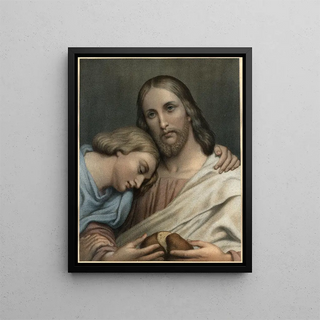Art print | The Christ and Saint John - Ary Scheffer


View from behind

Frame (optional)
In the vast panorama of art history, certain artworks stand out for their ability to capture the very essence of humanity. "The Christ and Saint John" by Ary Scheffer is one of those creations that transcend the simple pictorial frame to invite the viewer to a profound reflection on spirituality and the relationship between the divine and the human. This piece, created in the 19th century, perfectly illustrates the romantic style that prevailed at that time, blending intense emotion with delicate representation. The scene depicts a symbolic encounter, where the figures of Jesus and John the Baptist exchange looks filled with understanding and omen, offering a vision that is both intimate and universal.
Style and uniqueness of the work
Ary Scheffer's style is characterized by masterful use of light and shadow, creating an atmosphere that is both serene and dramatic. In "The Christ and Saint John," the artist manages to establish a subtle balance between the softness of the faces and the strength of the emotions conveyed. The color palette, dominated by warm and soothing tones, enhances this sense of serenity while emphasizing the gravity of the moment depicted. The drapery of the characters' clothing is rendered with such finesse that they seem almost tangible, adding a tactile dimension to the artwork. The composition, carefully orchestrated, guides the viewer’s gaze through the scene, inviting prolonged contemplation. Every detail, from Christ’s penetrating gaze to Saint John’s respectful posture, contributes to the narrative power of this piece, making it not just a painting but a true spiritual experience.
The artist and his influence
Ary Scheffer, born in 1795 in Dordrecht, Netherlands, is an emblematic figure of the Romantic movement. His career, marked by a constant search for the expression of feelings, makes him an essential artist of his time. Influenced by the great masters of painting, he develops a personal style that combines Romantic sensitivity with classical traditions. His works, often inspired by literary and religious themes, reflect a deep contemplation on the human condition. Scheffer also played a significant role in

Matte finish

View from behind

Frame (optional)
In the vast panorama of art history, certain artworks stand out for their ability to capture the very essence of humanity. "The Christ and Saint John" by Ary Scheffer is one of those creations that transcend the simple pictorial frame to invite the viewer to a profound reflection on spirituality and the relationship between the divine and the human. This piece, created in the 19th century, perfectly illustrates the romantic style that prevailed at that time, blending intense emotion with delicate representation. The scene depicts a symbolic encounter, where the figures of Jesus and John the Baptist exchange looks filled with understanding and omen, offering a vision that is both intimate and universal.
Style and uniqueness of the work
Ary Scheffer's style is characterized by masterful use of light and shadow, creating an atmosphere that is both serene and dramatic. In "The Christ and Saint John," the artist manages to establish a subtle balance between the softness of the faces and the strength of the emotions conveyed. The color palette, dominated by warm and soothing tones, enhances this sense of serenity while emphasizing the gravity of the moment depicted. The drapery of the characters' clothing is rendered with such finesse that they seem almost tangible, adding a tactile dimension to the artwork. The composition, carefully orchestrated, guides the viewer’s gaze through the scene, inviting prolonged contemplation. Every detail, from Christ’s penetrating gaze to Saint John’s respectful posture, contributes to the narrative power of this piece, making it not just a painting but a true spiritual experience.
The artist and his influence
Ary Scheffer, born in 1795 in Dordrecht, Netherlands, is an emblematic figure of the Romantic movement. His career, marked by a constant search for the expression of feelings, makes him an essential artist of his time. Influenced by the great masters of painting, he develops a personal style that combines Romantic sensitivity with classical traditions. His works, often inspired by literary and religious themes, reflect a deep contemplation on the human condition. Scheffer also played a significant role in






